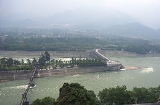
Dujiangyan City
Encyclopedia
Dujiangyan is a county-level city
of Chengdu
, Sichuan Province in China
. It has an area of 1208 square kilometers and a population of 600,000 in 2003.
Dujiangyan used to be a county named Guanxian or Guan County , in Chinese literally "irrigation" (guan) county (xian). The People's Republic of China
created a county-level city in 1988, and renamed it in honor of the Dujiangyan Irrigation System
, which is located in the northwestern area of the city, famous for still providing neighboring major city Chengdu
with water even though it was built around 250 BC.
during the Warring States Period
(475-221BC), Li Bing, a governor of Shu in the Qin state (present Sichuan Province) with his son directed the construction of Dujiangyan. The governor gave up the old way of dam building, which was simply trying to catch the floodwaters. Instead he employed a new method by channeling and dividing the water to harness the Min River. He accomplished this by separating the project into two main parts: the headwork and the irrigation system. The project effectively put flood waters under control. For over two thousand years the whole system has functioned perfectly, serving not only for flood prevention but also as an immense source for irrigation and a means to facilitate shipping and wood drifting. It has contributed greatly to the richness of Chengdu Plain with its reputation as "The Land of Abundance".
On 12 May 2008, the city was the closest to the epicenter
of the 2008 Sichuan earthquake
and the city suffered severe damage. Xinjian Primary School, Juyuan Middle School, and Xiang'e Middle School collapsed in the earthquake; Beijie Primary School did not collapse.
and 2 townships:
County-level city
A county-level city is a county-level administrative division of mainland China. County-level cities are usually governed by prefecture-level divisions, but a few are governed directly by province-level divisions....
of Chengdu
Chengdu
Chengdu , formerly transliterated Chengtu, is the capital of Sichuan province in Southwest China. It holds sub-provincial administrative status...
, Sichuan Province in China
China
Chinese civilization may refer to:* China for more general discussion of the country.* Chinese culture* Greater China, the transnational community of ethnic Chinese.* History of China* Sinosphere, the area historically affected by Chinese culture...
. It has an area of 1208 square kilometers and a population of 600,000 in 2003.
Dujiangyan used to be a county named Guanxian or Guan County , in Chinese literally "irrigation" (guan) county (xian). The People's Republic of China
People's Republic of China
China , officially the People's Republic of China , is the most populous country in the world, with over 1.3 billion citizens. Located in East Asia, the country covers approximately 9.6 million square kilometres...
created a county-level city in 1988, and renamed it in honor of the Dujiangyan Irrigation System
Dujiangyan Irrigation System
Dujiangyan is an irrigation infrastructure built in 256 BC during the Warring States Period of China by the Kingdom of Qin. It is located in the Min River in Sichuan province, China, near the capital Chengdu. It is still in use today to irrigate over 5,300 square kilometers of land in the region...
, which is located in the northwestern area of the city, famous for still providing neighboring major city Chengdu
Chengdu
Chengdu , formerly transliterated Chengtu, is the capital of Sichuan province in Southwest China. It holds sub-provincial administrative status...
with water even though it was built around 250 BC.
History
Around 250 BC250 BC
Year 250 BC was a year of the pre-Julian Roman calendar. At the time it was known as the Year of the Consulship of Regulus and Longus...
during the Warring States Period
Warring States Period
The Warring States Period , also known as the Era of Warring States, or the Warring Kingdoms period, covers the Iron Age period from about 475 BC to the reunification of China under the Qin Dynasty in 221 BC...
(475-221BC), Li Bing, a governor of Shu in the Qin state (present Sichuan Province) with his son directed the construction of Dujiangyan. The governor gave up the old way of dam building, which was simply trying to catch the floodwaters. Instead he employed a new method by channeling and dividing the water to harness the Min River. He accomplished this by separating the project into two main parts: the headwork and the irrigation system. The project effectively put flood waters under control. For over two thousand years the whole system has functioned perfectly, serving not only for flood prevention but also as an immense source for irrigation and a means to facilitate shipping and wood drifting. It has contributed greatly to the richness of Chengdu Plain with its reputation as "The Land of Abundance".
On 12 May 2008, the city was the closest to the epicenter
Epicenter
The epicenter or epicentre is the point on the Earth's surface that is directly above the hypocenter or focus, the point where an earthquake or underground explosion originates...
of the 2008 Sichuan earthquake
2008 Sichuan earthquake
The 2008 Sichuan earthquake or the Great Sichuan Earthquake was a deadly earthquake that measured at 8.0 Msand 7.9 Mw occurred at 14:28:01 CST...
and the city suffered severe damage. Xinjian Primary School, Juyuan Middle School, and Xiang'e Middle School collapsed in the earthquake; Beijie Primary School did not collapse.
Climate
Administrative divisions
Dujiangyan has 17 townsTown (China)
When referring to political divisions of China, town is the standard English translation of the Chinese 鎮 . It is a fourth-level administrative unit, i.e...
and 2 townships:
- Towns:
- Guankou (灌口镇)
- Xingfu (幸福镇)
- Puyang (蒲阳镇)
- Juyuan (聚源镇)
- Chongyi (崇义镇)
- Tianma (天马镇)
- Shiyang (石羊镇)
- Liujie (柳街镇)
- Yutang (玉堂镇)
- Zhongxing (中兴镇)
- Qingchengshan (青城山镇)
- Longchi (龙池镇)
- Xujia (胥家镇)
- Anlong (安龙镇)
- Daguan (大观镇)
- Zipingpu (紫坪铺镇)
- Cuiyuehu (翠月湖镇)
- Townships:
- Xiang'e (向峨乡)
- Hongkou (虹口乡)

